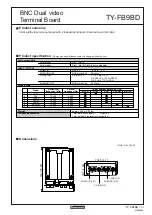
Page 14 COMMAND STATION MX1, MX1HS, MX1EC
The lower line is active during a sample run; that is after the recording
ocedures (lower
yback administration is full *)
*) can be freed by deleting sequences.
was started by pressing the appropriate number key for at least one
second.
This is especially useful to confirm whether the expected “events” are
coming and how much memory is being used up for this sequence.
The display also shows deleting actions and other pr
line); as well as error messages:
Error #2: Memory for pla
Error #3: Memory is full
Executing a stored operating sequence:
Described here using a MX2 cab, but equally valid when using a newer cab (MX31) if used “like an
MX21”. Future software versions of the MX31 will have extended adjusting and subsequent correc-
tive actions; see MX31 manual!
The playback is started the same way as a sample run recording, by entering the group address on
the cab as you would for a loco address but accepting it with the “A” key instead. The LED’s above
each number key (1….8) indicate whether the memory locations are empty or occupied:
Key-LED green: memory location is empty
Key-LED yellow: memory location is full (playback activation is possible)
To activate a stored operating sequence playback, press the key of the desired “yellow” memory lo-
cation; which is acknowledged by
Key-LED flashing yellow: operating sequence is running.
Before the operating sequence can be played back, the locomotives involved must be at their re-
spective starting positions, as they were when the sequence was started for the recording.
Any cabs showing an active loco address that is part of this sequence will have that address auto-
matically deactivated (address is flashing).
ATTENTION: The loco addresses part of an operating sequence must not be activated with the cab
while the sequence is being played back!!
To end a playback, press the same key briefly; all trains that are part of this sequence are being re-
turned to their starting location and automatically stopped. Once again the
Key-LED yellow: memory location is full but no longer in playback mode.
If the trains need to be stopped immediately, press the key twice.
AOS-specific information displayed by the command station:
Depending on the CV #101 setting (see below), useful information during playback of an operating
sequence is shown by the MX1 display either temporarily (about 20 sec, default) or permanently (CV
#101, Bit 0 =1).
The upper line shows common data about the AOS memory (as during a recording); the lower line is
of most interest about the “event” handling: it becomes visible whether the timing during playback
matches the sample run and whether the “events” are being recognized properly. For this purpose,
the “events” are shown with prefixes:
N.. = This is the next expected “event”; the playback of stored commands is being executed as
planned (that is after the stored “events”).
W ..= The “event” is expected now, that is no more commands are to be executed ahead of this
“event”. If the train is late (compared to the sample run), the playback is delayed until the “event” is
triggered in order to re-synchronize the sequence.
Sa
m
pl
in
ro
gr
Gr
ou
p
ad
dr
es
lo
ca
tio
n
num
be
r
La
st
re
co
gni
ze
sto
re
d
“e
v
C
urre
nt
ly
u
se
d
sp
ac
e
(B
yt
es
)
se
qu
e
S.. = The “event” was triggered earlier than expected (the train was faster than during the sample
run); the playback speed is increased to re-synchronize the sequence; that is the commands up to
this point are processed faster.
B..= The next “event” is (still) locked (because it is also the past “event” triggered by axles of the
train, which is being expected).
E.. = “Event” is happening.
X00 = This operating sequence contains no “events” (no synchronization possible).
MX1 – Configuration variables for Automatic Operating Sequences (AOS):
These parameters are absolutely valid for MX2 and MX21 cabs; with an MX31 cab and future soft-
ware version an individual setting for every operating sequence is possible. See MX31 manual!
CV #100
: Simulation of overdue “events”. In case an “event” that was stored during a sample run re-
cording has not been triggered, the sequence is aborted after 1 minute by default (CV #100 = 0);
most often though in connection with an accident (collision at the end of the run or similar). With
CV #100, Bits 0 – 5 = 0….63 a time is defined after which a reaction takes place if an “event” is over-
due, namely
when Bit 7, 6 = 00 the operating sequence is being aborted;
when Bit 7, 6 = 01 (d 64) the “event” is being simulated.
For example: If CV #100 = 69, the overdue “event” (compared to the recorded “event”) is generated
artificially after 5 seconds and the operating sequence will continue.
CV #101:
pertains to the MX1 display when executing a stored operating sequence; by default the in-
formation is displayed only briefly and thereafter switches back to the normal MX1 volt and amp me-
ter display. This does not affect the display during a sample run recording, which is always displayed
permanently:
Bit 0 = 0: Display is used “normally” (Volt and amp meter ….), not for AOS
Bit 0 = 1: The last activated sequence is continuously being displayed and updated.
e
ru
n
es
s
s
an
d
d an
d
ent
”
m
em
or
y
fo
r
th
is
nc
e
p















































